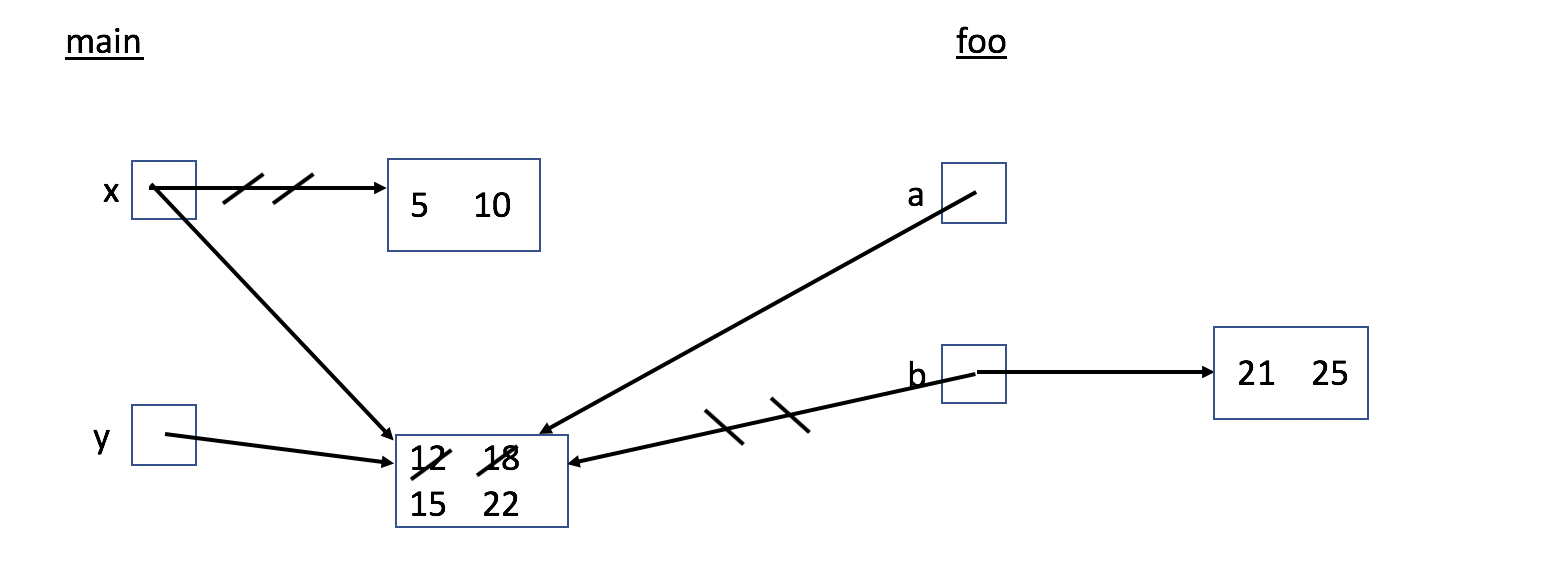
Part A.

Part B.
[15, 22] [21, 25] [15, 22] [15, 22]Part C. 3
Problem 2
Many correct solutions.
Part 1. (wrong)
temp: 105
return value: cool
Part 2. (right)
temp: 56
return value: cool
Problem 3
Several correct solutions; including some that involve doing a cd
to a different directory first.
cp ../../baz/* .
Problem 4 Solution shown in bold.
// Represents a "drunkard" doing a random walk along an integer number line.
// Drunkard chooses direction and step size randomly. Steps range in
// distance from 1 to MAX_STEP_SIZE, inclusive.
public class Drunkard1D {
public static final int MAX_STEP_SIZE = 10;
private int currLoc;
private Random random;
// Creates drunkard with given starting location.
// @param startLoc starting location of drunkard
public Drunkard1D(int startLoc) {
random = new Random();
currLoc = startLoc;
}
// Takes a random-length step of size in the range [1, MAX_STEP_SIZE] in
// a random direction on the number line.
public void takeStep() {
boolean goRight = random.nextBoolean();
int distance = random.nextInt(MAX_STEP_SIZE) + 1;
if (!goRight) { distance = -distance; }
currLoc += distance;
// Gets the current location of the drunkard. (accessor)
// @return an int representing drunkard's current location
public int getCurrentLoc() {
return currLoc;
}
}
Problem 5
Part A.
// returns location of target in namesArray or -1 if not found
private int lookupLoc(String target) {
for (int i = 0; i < namesArr.size(); i++) {
int result = target.compareTo(namesArr.get(i));
if (result < 0) { return -1; }
result == 0
if (target.equals(namesArr.get(i))) { return i; }
}
return -1;
}
Part B.
Here's the sample namesArr given on the exam (called A in the tests):
[Avinash, Carly, John, Mana, Peter, Sa, Yiqi]
target namesArr expected description of test case
Avinash A 0 first Yiqi A 6 last Mana A 3 somewhere in middle Li A -1 not present, target would have been somewhere in middle Andy A -1 not present, target comes before first element Zhao A -1 not present, target comes after last element Li [] -1 empty namesArr Carly ["Carly"] 0 present, 1-elmt namesArr Li ["Carly"] -1 not present, 1-elmt namesArr, target comes before element Abby ["Carly"] -1 not present, 1-elmt namesArr, target comes after element
Problem 6
Part A. M
Part B. C
Part C. M
Part D. M, C
Problem 7
The most straightforward solution is one using nested loops, below. Another less common solution was one using only one loop though the whole array, where periodically you hanve to reset upTo and count to make sure you are putting the right values in the array.
public static int[] createSequence(int n) {
int[] result = new int[n*(n+1)/2];
int loc = 0;
for (int upTo = 1; upTo <= n; upTo++) { // upTo is the number we are counting up to
// in this iteration of outer loop
for (int count = 1; count <= upTo; count++) {
result[loc] = count;
loc++;
}
}
return result;
}